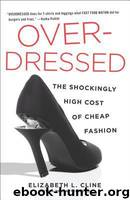Overdressed: The Shockingly High Cost of Cheap Fashion by Elizabeth L. Cline

Author:Elizabeth L. Cline [Cline, Elizabeth L.]
Language: eng
Format: mobi
Tags: History
ISBN: 9781101560587
Publisher: Penguin
Published: 2012-06-14T00:00:00+00:00
Maui and I took the elevator back downstairs and walked into a dimly lit warehouse hidden away on the far side of the donation drop-off area. This room, Maui informed me, is where the “rag-out” ends up, the donated clothing that languishes on thrift-store racks without getting sold or is too threadbare and stained or out of season to sell in the first place. Garments that make it into the Salvation Army thrift stores have exactly one month to sell. At Goodwill, clothes are given a similar three- to five-week window to prove themselves. Then they’re pulled from their hangers, tossed in bins, and end up back in a room such as this one.
In the rag-out room, two men were silently pushing T-shirts, dresses, and every other manner of apparel into a compressor that works like the back of a garbage truck, squeezing out neat cubes of rejected clothing that weigh a half ton each. The cubes were then lifted and moved via forklift to the middle of the room, where a wall of wrapped and bound half-ton bales towered. I saw tags for Old Navy, Sean Jean, and Diesel peeking out of the bales, as well as slivers of denim, knits in bright maroons and bold stripes, and the smooth surfaces of Windbreakers. Smashed together like this, stripped of its symbolic meaning, stacked up like bulk dog food, I was reminded that clothing is ultimately just fabric that comes from resources and can result in horrifying volumes of waste. Clothing stores completely separate us from this reality, but a rag-out room brings it home in an instant. The Quincy Street Salvation Army builds a completed wall made of eighteen tons, or thirty-six bales, of unwanted clothing every three days. And this is just a small portion of the cast-offs of one single Salvation Army location in one city in the United States.
Since the end of the nineteenth century in both Europe and the United States, philanthropic groups have been involved in the collection and distribution of clothes to the poor. The Salvation Army started up in the United States in 1870, at a time when the U.S. population was less than 40 million and almost all clothing was still handmade. It wasn’t until the late 1950s that charities opened retail outlets, and their income began to come primarily from the sale of used clothing.10 Charitable clothing donations from that point were used indirectly, by first selling clothes and then using the proceeds to fund charitable works. This is how clothing donations function today.
Then consumer culture set in. During the postwar period, growing incomes allowed Americans to buy more clothes. Our wardrobes became diversified, with juniors’ clothes, office clothes, sports clothes, and street wear becoming common.11 This was when charities started processing enormous yields of used but still wearable clothing. But it wasn’t until clothing prices started declining in recent decades that charities started seeing barely used and even unworn discarded clothing. Throughout the 1990s, donations to Goodwill increased 10 percent per year.
Download
This site does not store any files on its server. We only index and link to content provided by other sites. Please contact the content providers to delete copyright contents if any and email us, we'll remove relevant links or contents immediately.
Influence: The Psychology of Persuasion by Robert B. Cialdini(4599)
The Miracle Morning by Hal Elrod(4422)
The Hacking of the American Mind by Robert H. Lustig(4082)
Pre-Suasion: A Revolutionary Way to Influence and Persuade by Robert Cialdini(3975)
Unlabel: Selling You Without Selling Out by Marc Ecko(3467)
Ogilvy on Advertising by David Ogilvy(3327)
Hidden Persuasion: 33 psychological influence techniques in advertising by Marc Andrews & Matthijs van Leeuwen & Rick van Baaren(3292)
Purple Cow by Seth Godin(3069)
Who Can You Trust? by Rachel Botsman(3024)
Kick Ass in College: Highest Rated "How to Study in College" Book | 77 Ninja Study Skills Tips and Career Strategies | Motivational for College Students: A Guerrilla Guide to College Success by Fox Gunnar(2997)
This Is Marketing by Seth Godin(2901)
I Live in the Future & Here's How It Works by Nick Bilton(2844)
The Marketing Plan Handbook: Develop Big-Picture Marketing Plans for Pennies on the Dollar by Robert W. Bly(2792)
The Power of Broke by Daymond John(2770)
Building a StoryBrand by Donald Miller(2754)
The 46 Rules of Genius: An Innovator's Guide to Creativity (Voices That Matter) by Marty Neumeier(2678)
Draw to Win: A Crash Course on How to Lead, Sell, and Innovate With Your Visual Mind by Dan Roam(2639)
The Tipping Point by Malcolm Gladwell(2554)
Market Wizards by Jack D. Schwager(2538)
